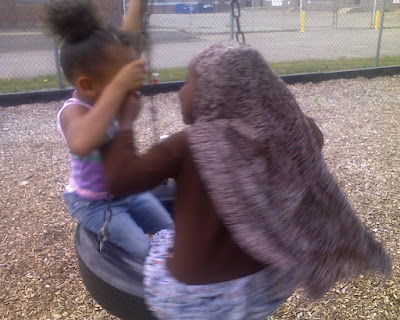Last month when I posted "I don't know my Somali neighbors," I never imagined the outpouring of positive responses. I did not imagine Somali and other East African people reaching out to me (and my readers) with information, perspective, and with open hands of friendship. But they did. And my world is forever changed.
In particular I've met and embraced a kindred spirit - Nimo Farah - a young, fierce, open-hearted woman who reposted my blog, offered up her wisdom, and then invited me for coffee. Since then we have begun the journey of real friendship, our commonalities of the soul far outweighing the differences of culture, age, religious practice, and lived experiences.
New friends, old souls, kindred spirits
I had the chance to hear Nimo read her poetry recently and she lit the room on fire with her passion. I am very excited that she has agreed to guest post one of those poems here.
So please welcome Nimo Farah. I invite you to find a place to sit down, perhaps with a cup of tea, to take in this amazing poem.
~~~
Covered
by Nimo Farah
She's covered it all
Draped body dancing freely
The breeze moved her layers of colorful textiles
Intermingling with the air
The trees embrace her
And the sun baths her
She belongs with them without a battle
But in the gray concrete jungle, she does not blend
You spot her from a mile, get nervous by her style
She doesn't pretend
You wish she did not stand out or blend in
There is no pleasing you without baring the skin
You want her to be normal
to blend with them
You think you are the judge of normal
But she's got a normal all her own.
She's covered it all
You wonder who this woman is
And who does she think she is?
She's covered it all,
And you want to be the judge of her beauty
So you scan her up and down
Fashion foreign to you
Her style flows like the Nile
No price on her apparel
No names or nouns for her attire
You see nothing familiar using your eyes
And you're not really concerned with who she really is
Or her intelligence
If every you're willing to spot her soul, she's willing to wear a smile
But you'd rather strip away her garments
Like a peeled fruit you want to leave her naked
But she knows the fate of a peeled fruit
Caressed by the air it is delicate and darkens
You want to caress her with your eyes
Spoil her with your stare
You wonder who this woman is
And who does she think she is?
She's covered it all.
You spot her in the hot summer sun
She continues not to share her skin
You wonder how she withstands the temper of the sun
She's brave with her ways but you want her to be free
So that she can dance in your dreams
You want to separate her body from spirit
Have one without the other
She resists like leaves resisting the wind
You wonder who this woman is
And who does she think she is?
She's covered it all.
And this you should know
Her garments are powerful!
They connect her with her mother
They're holy scripture
Linking her to the essence and strength of her creator
She loves the texture
And when she ties her scarves with her dresses
She makes strong ropes, escapes wars
Covered up she is superwoman
Walking through violent raindrops, sandstorms
And even bullets.
Her garments are more than material
They tell the stories of her struggle
As she roamed the world chasing peace
Her garments covered her scars
And healed her battle wounds
It is the hijab that was her shield from fear
The hijab that was her security blanket as an infant
Sentimental and sacred
And a test and a protest!
And if you are really wondering who this woman is
She is a woman warrior
With her hijab as her cape!
She's covered it all.
And honestly you don't care to know the depth beyond her exterior
So you bully her with your gaze
Til she shows you inches of her skin
But she's not
Not that kind of woman
She's a woman warrior with her hijab as her cape
And her powers remain a secret
She's covered it all.
~~~
Nimo Farah embraces her experiences as a refugee-Muslim-woman living in America but believes the human spirit it too multi-dimensional to categorize and classify. Exposed to many cultures and struggles, she is inspired to write about and celebrate the resilience, complexity, and compassion of the human spirit. She aspires to be a keeper of her ancestors' rich oral traditions and mother tongue; both are at the brink of being endangered.
Fierce poet, Minnesota style
Dancing at the Red Sea
"She is a woman warrior with her hajib as her cape..."



















